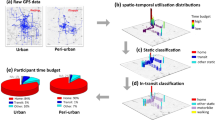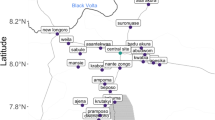Abstract
Manganese (Mn) is ubiquitous in the environment and essential for normal growth and development, yet excessive exposure can lead to impairments in neurological function. This study modeled ambient Mn concentrations as an alternative to stationary and personal air sampling to assess exposure for children enrolled in the Communities Actively Researching Exposure Study in Marietta, OH. Ambient air Mn concentration values were modeled using US Environmental Protection Agency’s Air Dispersion Model AERMOD based on emissions from the ferromanganese refinery located in Marietta. Modeled Mn concentrations were compared with Mn concentrations from a nearby stationary air monitor. The Index of Agreement for modeled versus monitored data was 0.34 (48 h levels) and 0.79 (monthly levels). Fractional bias was 0.026 for 48 h levels and −0.019 for monthly levels. The ratio of modeled ambient air Mn to measured ambient air Mn at the annual time scale was 0.94. Modeled values were also time matched to personal air samples for 19 children. The modeled values explained a greater degree of variability in personal exposures compared with time-weighted distance from the emission source. Based on these results modeled Mn concentrations provided a suitable approach for assessing airborne Mn exposure in this cohort.
This is a preview of subscription content, access via your institution
Access options
Subscribe to this journal
Receive 6 print issues and online access
$259.00 per year
only $43.17 per issue
Buy this article
- Purchase on Springer Link
- Instant access to full article PDF
Prices may be subject to local taxes which are calculated during checkout






Similar content being viewed by others
References
Agency for Toxic Substances and Disease Registry (ATSDR) Toxicological Profile for Manganese. US Public Health Service, US Department of Health and Human Services: Atlanta, GA, USA. 2012.
Mergler D, Baldwin M . Early manifestations of manganese neurotoxicity in humans: an update. Environ Res 1996; 73: 92–100.
Zota A, Schaider L, Ettinger A, Wright R, Shine J, Spengler J . Metal sources and exposures in the homes of young children living near a mining-impacted Superfund site. J Expos Sci Environ Epidemiol 2011; 21 (5): 495–505.
World Health Organization. Air Quality Guidelines 2nd Edition. Manganese. Available at: http://www.euro.who.int/__data/assets/pdf_file/0003/123078/AQG2ndEd_6_8Manganese.pdf (last accessed 8 May 2015).
Menezes-Filho J, Bouchard M, Sarcinelli P, Moreira J . Manganese exposure and the neuropsychological effect on children and adolescents: a review. Pan American Journal of Public Health 2009; 26 (6): 541–548.
Drown D, Oberg S, Sharma R . Pulmonary clearance of soluble and insoluble forms of manganese. J Toxicol Environ Health 1986; 17: 201–212.
Dorman D, Brenneman K, McElveen A, Lynch S, Roberts K, Roberts B . Olfactory transport: a direct route of delivery of inhaled manganese phosphate to the rat brain. J Toxicol Environ Health 2002; 65 (20): 1493–1511.
Winder B . Manganese in the air: are children at greater risk than adults? J Toxicol Environ Health 2010; 73: 156–158.
Mergler D, Baldwin M, Belanger S, Larribe F, Beuter A, Bowler R et al. Manganese neurotoxicity, a continuum of dysfunction: results from a community based study. NeuroToxicol 1999; 20 (2–3): 327–342.
Zoni S, Albini E, Lucchini R . Neuropsychological testing for the assessment of manganese neurotoxicity: a review and a proposal. Am J Ind Med 2007; 50: 812–830.
Haynes EN, Sucharew H, Kuhnell P, Alden J, Barnas M, Wright R et al. Neurocognition and exposure to manganese in children residing in rural Appalachian Ohio. Environ Health Perspect. 2015; 123 (10): 1066–1071.
Riojas-Rodriguez H, Solis-Vivanco R, Schilmann A, Montes S, Rodriguez S, Rios C et al. Intellectual function in Mexican children living in a mining area and environmentally exposed to manganese. Environ Health Perspect 2010; 118 (10): 1465–1470.
Hernandez-Bonilla D, Schilmann A, Montes Y, Rodriguez-Agudelo Y, Rodriguez-Dozal S, Solis-Vivanco R et al. Environmental exposure to manganese and motor function of children in Mexico. NeuroToxicology 2011; 32: 615–621.
Menezes-Filho JA, Novaes C, Moreira JC, Sarcinelli PN, Mergler D . Elevated manganese and cognitive performance in school-aged children and their mothers. Environ Res 2011; 111: 156–163.
Lucchini R, Guazzetti S, Zoni S, Donna F, Peter S, Zacco A et al. Tremor, olfactory and motor changes in Italian adolescents exposed to historical ferro-manganese emission. NeuroToxicology 2012; 33: 687–696.
Carvalho C, Menezes-Filho J, de Matos V, Bessa J, Coelho-Santos J, Viana G et al. Elevated airborne manganese and low executive function in school-aged children in Brazil. NeuroToxicology 2014; 45: 301–308.
Torres-Agustin R, Rodriguez-Agudelo Y, Schilmann A, Solis-Vivanco R, Montes S, Riojas-Rodriguez H et al. Effect of environmental manganese exposure on verbal learning and memory in Mexican children. Environ Res 2013; 121: 39–44.
Rugless F, Bhattacharya A, Succop P, Dietrich K, Cox C, Alden J et al. Childhood exposure to manganese and postural instability in children living near a ferromanganese refinery in Southeastern Ohio. Neurotoxicol Teratol 2014; 41: 71–79.
Haynes E, Heckel P, Ryan P, Chen A, Brown D, Roda S et al. Assessment of personal exposure to manganese in children living near a ferromanganese refinery. Sci Total Environ 2012; 427-428: 19–25.
US Environmental Protection Agency. User’s Guide for the AMS/EPA Regulatory Model AERMOD. US EPA: Washington, DC, USA; EPA-454/B-03-001.
Silverman KC, Tell JG, Sargent EV, Qiu Z . Comparison of the Industrial Source Complex and AERMOD Dispersion Models: case study for human health risk assessment. J Air Waste Manage Assoc 2007; 57: 1439–1446.
Wang S, Tang X, Fan Z, Wu X, Lioy P, Georgopoulos P . Modeling of personal exposures to ambient air toxics in Camden, New Jersey: an evaluation study. J Air Waste Manage Assoc 2009; 59: 733–746.
Zou B, Zhan F, Wilson J, Zeng Y . Performance of AERMOD at different time scales. Simul Model Pract Theory 2010; 18: 612–623.
Haynes E, Beidler C, Wittberg R, Meloncon L, Parin M, Kopras E et al. Developing a bidirectional academic-community partnership with an Appalachian-American Community for Environmental Health Research and Risk Communication. Environ Health Perspect 2011; 119 (10): 1364–1372.
US Environmental Protection Agency. Emissions Inventory System (EIS). Available at: http://www.epa.gov/ttn/chief/eis/gateway/index.html (last accessed 8 May 2015).
Ohio Environmental Protection Agency. Emissions Inventory System. Available at: http://www.epa.ohio.gov/dapc/aqmp/eiu/eis.aspx (last accessed 8 May 2015).
US Environmental Protection Agency. Toxic Chemical Release Inventory Reporting Forms and Instructions. Revised 2014 Version; EPA-260-R-15-101. Available at: http://www2.epa.gov/sites/production/files/2015-01/documents/rfi_ry2014_111914.pdf (last accessed 15 June 2015).
Carter MR, Gaudet BJ, Stauffer DR, White TS, Brantley SL . Using soil records with atmospheric dispersion modeling to investigate the effects of clean air regulations on 60 years of manganese deposition in Marietta, Ohio (USA). Sci Total Environ 2015; 515–516: 49–59.
National Oceanic and Atmospheric Agency. Surface meteorological data in ISHD format. Available at: ftp://ftp.ncdc.noaa.gov/pub/data/noaa (last accessed 8 May 2015).
National Oceanic and Atmospheric Agency.. ASOS 1-minute data. ftp://ftp.ncdc.noaa.gov/pub/data/asos-onemin/ (last accessed 8 May 2015)..
National Oceanic and Atmospheric Agency.. Upper air meteorological data. http://esrl.noaa.gov/raobs/ (last accessed 8 May 2015).
US Environmental Protection Agency.. AERMINUTE User’s Instructions. Available at: http://www.epa.gov/ttn/scram/models/aermod/aerminute_userguide_v11059_draft.pdf (last accessed 8 May 2015).
Multi-Resolution Land Characteristics Consortium.. MRLC Consortium Viewer. Available at: http://www.mrlc.gov/viewerjs/ (last accessed 8 May 2015).
US Environmental Protection Agency. AERSURFACE User’s Guide. US EPA: Washington, DC, USA; EPA-454/B-08-001.
US Environmental Protection Agency. User’s Guide for the AERMOD Meteorological Preprocessor (AERMET). US EPA: Washington, DC, USA; EPA-454/B-03-002.
US Environmental Protection Agency. User’s Guide for the AERMOD Terrain Preprocessor (AERMAP). US EPA: Washington, DC, USA; EPA-454/B-03-003..
Lakes Environmental Software. AERMOD View Version 7.6. Lakes Environmental: Waterloo, Ontario, Canada.
Barton C, Zarzecki C, Russell MA . site-specific screening comparison of modeled and monitored air dispersion and deposition for perfluorooctanoate. J Air Waste Manage Assoc 2010; 60: 402–411.
US Environmental Protection Agency. Protocol for Determining the Best Performing Model. US EPA: Washington, DC, USA; EPA-454/R-92-025.
US Environmental Protection Agency Integrated Risk Information System (IRIS) on Manganese. CASRN-7439-96-5. National Center for Environmental Assessment, Office of Research and Development: Washington, DC, USA. 1999.
US Environmental Protection Agency.. EPA Schools Monitoring Initiative: Fact Sheet. Available at: http://www.epa.gov/schoolair/about.html (last accessed 8 May 2015).
Haynes E, Heckel P, Ryan P, Roda S, Leung Y, Sebastian K et al. Environmental manganese exposure in residents living near a ferromanganese refinery in Southeast Ohio: a pilot study. NeuroToxicology 2010; 31 (5): 468–474.
Bowler R, Harris M, Gocheva V, Wilson K, Kim Y, Davis S et al. Anxiety affecting Parkinsonian outcome and motor efficiency in adults of an Ohio community with environmental airborne manganese exposure. Int J Hyg Environ Health 2012; 215: 393–405.
Colledge MA, Julian JR, Gocheva VV, Beseler CL, Roels HA, Lobdell DT et al. Characterization of air manganese exposure estimates for residents in two Ohio towns. J Air Waste Manage Assoc 2015; 65 (8): 948–957.
US Environmental Protection Agency. Toxic Release Inventory. Available at: http://iaspub.epa.gov/triexplorer/tri_release.chemical (last accessed 15 June 2015).
Sayre J, Charney E, Vostal J, Pless I . House and hand dust as a potential source of childhood lead exposure. Am J Dis Children 1974; 127: 167–170.
Bornschein RL, Succop P, Dietrich KN, Clark CS, Que Hee S, Hammond PB . The influence of social and environmental factors on dust lead, hand lead, and blood lead levels in young children. Environ Res 1985; 38: 108–118.
Lanphear B, Weitzman M, Winter N, Eberly S, Yakir B, Tanner M et al. Lead-contaminated house dust and urban children’s blood lead levels. Am J Public Health 1996; 86 (10): 1416–1421.
Lanphear B, Roghmann K . Pathways of lead exposure in urban children. Environ Res 1997; 74: 67–73.
Succop P, Bornschein R, Brown K, Tseng C . An empirical comparison of lead exposure pathway models. Environ Health Perspect 1998; 106 (6): 1577–1583.
US Environmental Protection Agency. Child-Specific Exposure Factors Handbook (Final Report). US Environmental Protection Agency, Washington, DC, USA; EPA/600/R-06/096F.
Cortez-Lugo M, Rodriquez-Dozal S, Rosas-Perez I, Alamo-Hernandez U, Riojas-Rodriguez H . Modeling and estimating manganese concentrations in rural households in the mining district of Molango, Mexico. Environ Monit Assess 2015; 187: 752–762.
Jazcilevich A, Wellens A, Siebe C, Rosas I, Bornstein R, Riojas-Rodriguez H . Application of a stochastic vehicular wake erosion model to determine PM2.5 exposure. Aeolian Res 2012; 4: 31–37.
Acknowledgements
We acknowledge Joshua Mickle, Derek Hennen, Russellitta Young, Pierce Kuhnell, Jody Alden, Mary Barnas, Dawn Wittberg, James Thurman, and the CARES Advisory Board. The views expressed in this paper are those of the authors and do not necessarily represent the views or policies of the US Environmental Protection Agency. This work was supported by funding from National Institute of Environmental Health Sciences (1R01 ES016531) and NIEHS (1RO1 ES016531 and P30ES006096). This work was completed in partial fulfillment of the Doctor of Philosophy degree in Epidemiology in the Department of Environmental Health, Division of Epidemiology, University of Cincinnati College of Medicine.
Author information
Authors and Affiliations
Corresponding author
Ethics declarations
Competing interests
The authors declare no conflict of interest.
Rights and permissions
About this article
Cite this article
Fulk, F., Haynes, E., Hilbert, T. et al. Comparison of stationary and personal air sampling with an air dispersion model for children’s ambient exposure to manganese. J Expo Sci Environ Epidemiol 26, 494–502 (2016). https://doi.org/10.1038/jes.2016.30
Received:
Accepted:
Published:
Issue Date:
DOI: https://doi.org/10.1038/jes.2016.30
Keywords
This article is cited by
-
Short- and long-term exposure to trace metal(loid)s from the production of ferromanganese alloys by personal sampling and biomarkers
Environmental Geochemistry and Health (2022)
-
AERMOD modeling of ambient manganese for residents living near a ferromanganese refinery in Marietta, OH, USA
Environmental Monitoring and Assessment (2021)



